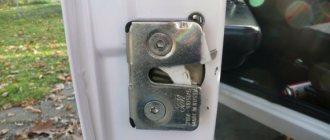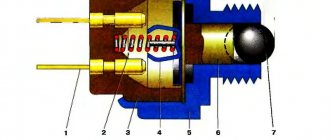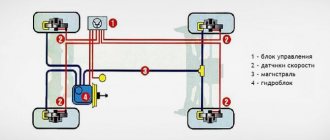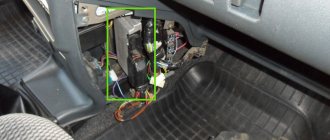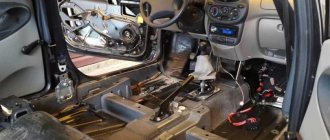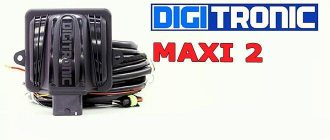Lada Priora (VAZ 2170) is one of the few domestically produced cars equipped with such a multifunctional device as an electrical package control controller. However, what is it and what controller is on the Priora?
The power package controller is a device that controls all of the vehicle's electrical functionality. Thus, this regulator is responsible for the operation of the turn signals, power windows, instrument panel lighting, side lights, fog lights, interior lighting, heated rear window, and reversing lights. Equipping a car with such a control unit makes it more practical in terms of using electronics.
The electrical package control controller on the Priora is mounted using brackets in the central, lower part of the dashboard above the engine control unit (ECU). On the Lada Priora, the controller is connected via two connectors: the power connector is responsible for supplying energy to the control unit, and the information connector is responsible for its direct functions. Also, the unit is equipped with protection from moisture and dust.
Essentially, the Priora electrical package controller is a circuit in a plastic case. The board itself (circuit) consists of 15 chips, each of which has its own purpose.
Purpose of parts on the board of the Priora electrical package control unit 2170-3763040.
Diagram of the Priora electrical package control unit 2170-3763040.
POS - interior lamp; ZPTO - rear fog lights; BS - low beam; PTF - fog lights; MDV - driver's door module; PUP - direction indicator switch; PAS - hazard warning switch; FPD - front right door; FLD - front left door; ZPD - rear right door; ZLD - rear left door; PS - passenger door power window switch; FOB - trunk light; ZP - right mirror; ZL - left mirror; GO - side lights; UP - direction indicators.
The pinout of the electrical package controller on a Priora car is an electrical process, the complexity of which is explained by the versatility of the unit. In this regard, many wires of different functionality are connected to the controller - the unit is connected by more than 25 wires.
The machine electronics control unit has several operating conditions:
- air temperature from -45°C to +40°C;
- atmospheric pressure up to 800 mm Hg. or 105 kPa;
- air humidity up to 90%;
- operating voltage range from 9 to 15 V.
Failure of the electrical package controller may be caused by overheating of the system or disconnection of wires. In this case, it is necessary to inspect the control unit itself. On a Lada Priora car, the controller is located above the engine, and in case of malfunction or interference, it will be necessary to remove the dashboard.
"Lada Priora" drives around the city. Here is the crossroads. Required traffic light signal. And the planned turn takes place. The driver's hand habitually pressed the steering column switch. But the warning light is not blinking. From all sides there are indignant beeps and screams. Turned without signaling! The driver embarrassedly presses the hazard warning button to stop and investigate. However, there is no response here either. Yeah! It's probably the turn signal relay! It needs to be changed, that's all! Fortunately, auto parts stores are everywhere now. But here, too, not everything is so simple. It seems that the “electrical package” or, as it is also called, the Priora comfort unit, has failed.
What is an immobilizer in Priora?
Characteristics of the immobilizer on Priora Immo on VAZ cars is a device that activates the power unit locking system in the event of a car break-in. The presence of a lock allows you to start the engine only after recognizing the key installed in the lock.
Interesting materials:
How long does it take to cook poses in a saucepan? How long should you cook raw shiitakes? How long does it take to cook rolled oatmeal? How many watts should a UV lamp have? How many vertices and how many angles does a triangle have? How much does 1 carat of ruby weigh? How much does 1 cube of liquid oxygen weigh? How much does 1 Kfs Nuggets weigh? How much does 1 samsa weigh? How much does iPhone 5s weigh?
Why turns and emergency lights don't work on Priore2
This problem is very widespread on Priora cars of the restyled version, which manifests itself in the form of a non-working turn signal. Such a “sore” is also known on other models of VAZ-produced cars, but the main reason for its manifestation is the TsBKE. If at one point the right or left side of the turns (or both sides) stops working on the car, then you should immediately resort to troubleshooting. It is important not to waste time with this process, since operating a vehicle with non-functioning turn signals is unsafe and can cause an accident. However, there is another equally important reason why it is worth immediately identifying the breakdown and fixing it. It lies in the fact that a non-functioning turn signal often occurs due to the burnout of a chip called BTS 5242-2L.
Interesting! The BTS 5242-2L chip is a power switch that is responsible for supplying current to the turn signal lamps.
This chip is a weak point in the body electronics units on Priora2 cars, which can even cause a fire. The electronic element does not have a current reserve (the maximum value is 6A), which, if overheated, fails. It is important to understand that the CBKE circuit uses two such chips, but one of them is responsible for the operation of left and right side turns, respectively, and the second ensures the functioning of DRLs and interior lighting.
Interesting! To understand the reason why the weak point is the BTS 4242-2L chip in the comfort units on Priors 2, you should know that at the moment the turns are turned on, the resistance of an unheated incandescent lamp is minimal. As a result, the current in the circuit increases, which leads to overheating of the element.
To prevent the possibility of failure of the TsBKE on Priors2, which often led and continues to lead to fires of these units, AVTOVAZ used new firmware. There was even a recall campaign to re-flash the blocks. However, even the new firmware did not solve this problem, and as a result, Prior car owners of restyled versions continue even today to encounter problems with corner malfunctions (most often they “stick” or simply do not function). Only since 2015 (since July) the updated Priora received new body electronics units, in which the problem with turning malfunctions was prevented (read more about this below).
The failure of the BTS 5242-2L chip on Priore2, which is responsible for the operation of turns, is manifested by the following factors:
- Constantly working turns on the right or left side of the car (this process is called “sticking”), which cannot be turned off not only using the steering column switch (guitar), but also by turning off the ignition. This is the most common symptom that indicates a malfunction of the CBKE. In such a situation, you should immediately stop the car, turn off the engine and disconnect the minus terminal to prevent the vehicle from catching fire.
- On one of the sides the turns stop working, and the lamp on the panel blinks at double frequency.
- The turns do not work on both sides of the car, which indicates that two chips on the CBKE board are faulty.
With all the above symptoms, you should not delay repairs. You should immediately disconnect the electrical equipment from the battery and begin repair work. The repair process depends on the condition of the TsBKE board. If you're lucky, you can see the following picture of the state of the BTS 5242-2L chips on the board, as shown in the photo below.
In the photo above you can see only a slight blackening of the board next to the chip, which is on the right. This indicates that it burned out. This type of malfunction is solved by replacing the chip with a new one. To do this, you will need to resolder it using a special soldering station or several soldering irons with thin tips. In the absence of skills and special equipment, it is better to entrust the work to electronics specialists.
If a pattern is found, as shown in the photo below, then the board can no longer be repaired, and you will only need to buy a new unit. Its average price is about 5,000 rubles. This is much more expensive than buying a chip and re-soldering it (the chip costs about 300 rubles and labor costs about 150 rubles).
In order not to have to buy a new unit, you should immediately, at the first sign of a malfunction in the turns of the car, resort to removing the central control unit and repairing it.
Important! To minimize the likelihood of failure of the CBKE in the direction of non-working turns, the alarm system should be used as little as possible. Turning it on for a long period of time often ultimately leads to corresponding breakdowns.
Classification of CBKE
Types of CBKE, features and their interchangeability
:
- 21900-3840080-20 Priora 2, Granta, Kalina 2 (in luxury trim levels), Datsun Ondo (Dream 1-2)
- 21900-3840080-10 Priora 2, Granta, Kalina 2 (in standard configurations)
- 21900-3840080-11 Priora 2 in the Standard configuration. Until 2016, Priora 2 was installed in the standard configuration
- 21900-3840080-21 Priora 2 in the Lux configuration early (2014-2015), not installed on the Norma, but will fit
- 21900-3840080-15 Priora 2 in Standard configuration, Kalina 2, Granta in Comfort configuration
- 21900-3840080-30 Datsun Mido in the Trust 1-3 configuration until 2015
- 21900-3840080-40 Datsun Mido in Dream 1, Dream 2 trim levels until 2015
- 21900-3840080-50 new block to replace 21900-3840080-10 (does not burn out)
- 21900-3840080-60 new block to replace 21900-3840080-20 (does not burn out)
- 8450100527 Grant from 2022
- 8450100534 Kalina 2 from 2022
- 8450100535 Datsun Ondo from 2022
- 8450100536 Datsun Mido from 2022 (Trust 1-3, Dream 1-2)
- 8450101126 Granta FL in the Classic, Optima and Comfort trim levels exclusively in cars with AMT (to implement the creeping AMT 2.0 mode, a door open signal is needed in the CAN bus, so it was necessary to introduce TsBKE)
- 8450101145 Granta FL in Luxe package
The TsBKE block is available in ours (ask about availability in the comments).
Ignition system diagram Lada Kalina Lux
1 — oil pressure warning lamp sensor; 2 — coolant temperature indicator sensor; 3 — additional fuse block; 4 — fuses for the electric fan of the engine cooling system; 5 — electric fuel pump relay; 6 — relay for the electric fan of the engine cooling system; 7 - ignition relay; 8 — relay 2 of the electric fan of the engine cooling system; 9 — relay 3 of the electric fan of the engine cooling system; 10 — electric fan of the engine cooling system; 11 — throttle position sensor; 12 — idle speed regulator; 13 — coolant temperature sensor; 14 — diagnostic block; 15 — ignition system harness block to the instrument panel harness block; 16 — solenoid valve for purge of the adsorber; 17 — speed sensor; 18 — ignition system harness block to instrument panel harness block 2; 19 — mass air flow sensor; 20 — crankshaft position sensor; 21 — oxygen sensor; 22 - controller; 23 — rough road sensor; 24 — diagnostic oxygen sensor; 25 — ignition coil harness block to the ignition system harness block; 26 — ignition coils: 27 — ignition system harness block to the ignition coil harness block; 28 — spark plugs; 29 — nozzles; 30 - resistor; 31 — air conditioning system pressure sensor; 32 — blocks of the ignition system harness and injector wiring harness; 33 - phase sensor; 34 - knock sensor.
Types of compatible window regulators
One of the most common models on the aftermarket is the window regulator for the Priora Forward. This model of electric lift is made in a combined arrangement of the drive and the actual rack-and-pinion lifting mechanism, compactly combined with the glass guide. Lifts of this model are characterized by increased reliability and ease of installation on Priora.
Garnet is the second most popular system. Under this name there is not even a single model, but a whole family, each modification of which is intended for a specific car. The mechanism is also rack and pinion type and has earned many good reviews from car enthusiasts. This type of lifts is characterized by uninterrupted operation, fast speed of raising/lowering the glass, and low noise.
It has already been said above about glass closers. In the luxury package they are available on all doors, but their performance leaves much to be desired. It is necessary to resort to replacement with other similar devices. One of the available alternatives is the Master system. It allows you to automatically raise the windows when the anti-theft system is turned on, and even control them within half an hour from the moment the ignition is turned off. The device itself looks like an electronic board with connectors connected to the standard Priora wiring.
The master is not very expensive (from 700 rubles), and its installation does not affect the door trim in any way. The whole procedure consists of removing the rear door sill trims, bending the sound insulation and connecting the door closer to the connector.
For the front doors, the Master will by default raise and lower the windows without ignition, and for the rear doors you need to install a slightly different version, called Master Plus. There are no differences in installation, the main thing is not to forget to disconnect the negative battery before starting work. The wizard has many other useful functions, for example, it automatically turns off the radio when the car is armed.
How to change the bulbs in the headlight of a VAZ 2170
To replace the low beam bulb, wear clean gloves and disconnect the battery.
Then remove the rubber protective cap, which is located closer to the fender.
Carefully disconnect the wires.
- Remove the latch (to do this, press down and remove it from behind the hooks).
- Remove the lamp and install a new one. Installation is carried out in reverse order.
Replacing high beam bulbs is no different.
If you frequently drive at night, especially in bad weather, make sure you always have a spare set of light bulbs in your car. Probably every driver has experienced the fact that one lamp burns out at night and the lighting becomes much worse. You also endanger other road users, since it is difficult to assess the situation during the same overtaking when one of the headlights of the oncoming car is not on.
To replace the bulbs in the rear light, you will need to dismantle it. (see Replacement of the rear light)
Remove the taillight and turn the parking lamp (in the Priora, the parking light is combined with a double-filament fog lamp).
Remove the lamp by turning it counterclockwise.
Install a new one. Make sure that the tabs on the plinth fit into the grooves on the parton. All other lamps are changed in the same way.
To replace the rear license plate lamp on a Lada Priora you need:
Remove the lock trim.
Unscrew the trunk lid attachment, which is secured with 4 bolts
Remove the socket and change the light bulb.
If you cannot remove the cartridge itself, remove the flashlight itself
To do this, you need to bend the plastic clamp a little (Caution, they are very fragile). After this, you can apply a little more force to unscrew
Install everything in reverse order
If you want to change the trunk light bulb, then:
Pull the lantern out of the opening as in the picture below.
- Bend the antennae that hold the lamp and change it.
- Reinstall the lantern in its original location.
At this point the repair can be considered complete. Connect the battery and check operation. If the replacement does not help, then most likely you should check the wiring.
How to disarm the electrical package unit of LADA PRIORA
What to do if Priora is not removed from the standard alarm!
The hazard warning light blinks, the car does not respond to the ignition key buttons. As a rule, several units are involved here that are synchronized with each other.
- Ignition
- Radio channel module (Located in the driver's door)
- Electrical package block (Comfort block)
- Engine ECU
New blocks come with non-activated codes inside and can be installed on any car without problems, but once you register (train) the keys, a special code is written into all these blocks, which is synchronized with each other and serves as a standard alarm system. (Immobilizer) As soon as you turn the ignition key, within five seconds there is a poll between the key and the units, if the code matches everywhere, then the engine ECU gives permission to start, if the code of at least one device is not recognized, the engine ECU is blocked and the car does not start.
Training a working key is done using a special red training key. I will not describe the procedure for training keys; there is plenty of information on the Internet. In fact, the main key is a red training key; it stores a code that, after training, is written into the working key and other blocks.
I'll try to explain in more detail how it all works:
- The radio channel code that we use to open doors using the key's remote control buttons is written into the driver's door module, where the power window buttons are located. If you replace the comfort unit or engine ECU, the buttons on the key will still work.
- The IMMO (Immobilizer) code has a connection only with the ignition key, the electrical package unit and the ECU unit. If you disconnect the driver's door module, the car will still start.
How to determine whether the keys are trained or not:
- The IMMO lamp on the instrument panel goes out after 5 seconds - the keys are trained.
- The IMMO lamp goes out after 30 seconds - the keys are not trained. (The car will start with any blank)
Basket
Double-glazed window control unit “Norma” 1118 – 6512010 for VAZ 11183 “Kalina”
©Aktuator On cars of the Kalina family, 2 types of non-interchangeable (by wiring) glass control controller 1118 - 6512010 and 11180 - 3763040 can be installed. 1118 – 6512010 has one 25-pin connection connector, 1118 – 3763040 (1118 – 3763040 – 10) – two connectors.
Remote control system for double-glazed windows “norm” on a VAZ 11183, Kalina. Controls power windows and central door locking. When the connector is removed, the engine does not start; the device performs some of the anti-theft functions.
Connection
pinout, electrical package control controller and circuit
Almost all modern cars today are equipped with electric windows, which allow you to control the opening of the windows at the touch of a button. And the Russian Priors in this case are no exception. The control device, with the help of which the windows are raised and lowered, as well as many other functions, is called the Priora comfort unit. You can learn more about its structure, as well as repair, from this article.
Description of the electrical package control unit
The electrical package controller in Priora is a device used to control the functionality of the vehicle. This unit is responsible for the operation of turn signals, power windows, control panel lighting, dimensions, fog lights, interior lighting, and rear window heating system. This device also ensures the normal operation of the reversing lights. The fact that the car is equipped with this device makes it even more practical.
Location
The control device on the Priora is located above the electronic engine control unit, at the bottom of the center console, in the middle. In this case, the device is connected using two connectors - power and information. The power output is used to supply voltage to the control unit, and the information output is used to perform the functions of the device. It should also be noted that the control unit is protected from external influences of dirt and moisture.
We install a new panel on a VAZ 2110
An important part of the car interior is the panel. The torpedo from the VAZ 2110 is morally outdated, although of course most drivers are still happy with it. Installing a torpedo from a Lada Priora to a ten is a troublesome task, but it’s worth it. The VAZ 21104 panel is more modern and convenient, although the quality of the plastic leaves much to be desired. The exception is wiring. You'll have to tinker with it a little longer. But we'll talk about this later.
Removing a panel from tens turns out to be not an easy task. And you can’t just pull one out and put the other in. But it’s quite possible to remove the old panel yourself. To do this, you will need several types of screwdrivers (two Phillips with a long and short blade and one simple), a 10mm deep socket, wire cutters, and a flashlight.
When starting removal, the first thing you need to do is disconnect the negative terminal from the battery. For additional convenience, you can remove the two front wheels, this will provide additional space for such labor-intensive work.
We immediately take out the simplest elements from the VAZ 2110 dashboard, such as: the standard clock, the heater control unit, the display unit, as well as the central deflector and radio. Then we unscrew the screws located on the sides that hold the tunnel. Remove the housing from the gearshift lever and take it out. Next we dismantle the steering wheel casing and steering wheel. To do this, unscrew the self-tapping screws and fixing screws.
Communities › DRIVE2 Naberezhnye Chelny (Tatarstan) › Forum › Comfort block on VAZ 2110
Auto electricians hey? Help me connect the comfort unit from the Priora to the ten. I couldn’t figure out how to connect the power window control unit and the heater control unit, I connected the heater fan knob itself, I can’t connect the air flow control (down, glass, etc.) and the air supply (heat-cold). Who can connect? Otherwise, winter is coming, it’s cold to drive in the car, services don’t take on alterations, only repairs. I scoured the Internet and found little results.
Do you have up-down control with a motor or not?
The power window control unit (which is on the door) sends signals via a kind of CAN bus to the comfort unit (also known as the standard alarm system). If you have sub-panel wiring from the Priora, all that remains is to find and connect the door wiring. If not, look for the wiring in the panel, otherwise it will be very annoying to connect. you will have to download the electrical diagram of the Priora and connect everything according to it. Everything is painted there in detail, what color wire goes where. There should even be drawings of the connectors. and about the stove: Do you have the air distributor inside the panel from Prior or your old one? and with manual control or motor?
Lada 2110 EMERALD › Logbook › Priora wiring on Lada 2110
First, about the wiring and configuration. In order not to burden yourself with unnecessary expenses (buying an air conditioner, abs, etc., etc.), the wiring was required to be as empty as possible. Yes, maybe someday I will want a Conder, but now it’s a big waste of money that was not included in the plans. I found a 2007 Priora while dismantling. I arrived, the wiring was virgin, I removed it almost completely myself. As far as I know, only in 7-8 years there were wiring without abs and everything else, so it fit perfectly and the price was cheap. I began to disassemble it and add there the options that I had in the cabin. Let me remind you: luxury ceiling lamps - 2 pcs. Luxury footlight lamps in the front doors - 2 pcs., installation of rear windows, heated seats, SE mirrors. And it turned out that again there were heaps and heaps of solders and additional harnesses on the wiring. I gave up this idea and ordered only the salon one
wiring for Priora Lux 2012. The wiring was the most complete luxury: all lamps, all power windows, heated seats, rear parking sensors, belts with pretensioners, rain/light sensor. There was only one question: would the empty under-panel and under-hood wiring of the 2007 Priora be suitable for the interior luxury wiring of the 2012 Priora? I couldn't find this information absolutely anywhere on the Internet. After studying the diagrams, I realized that everything should be fine.
In one it arrives, in the other it decreases. Alas, I can’t do without additional gaskets, because now the under-panel wiring does not quite meet my needs. This is what I will consider and describe here. I need to add in the UNDER PANEL WIRING:
1. Heated seats 2. Front fog lights 3. Accordingly, splice the wiring of the priors with the injection spit 2110 (January 5.1). I will also write about this in detail. I do everything according to the factory diagrams through the fuse box.
It's quite easy to add. All that is required is to add relay K11 and fuse F19 in the fuse block. The fuse block has standard female contacts. We crimp and insert according to the diagram and that’s it). I did not solder all the connections, but cut them and re-crimped them with the addition of a wire to the K11 relay.
Replacement features
Briefly about the procedure for replacing the control module on Kalina 2:
- First, the instruments are dismantled from the center console; there is nothing difficult about it.
- Then the lower part of the center console trim is unscrewed, the trim is removed, and you gain access to the fuse and relay box.
- The mounting block with safety devices can be unscrewed, but it cannot be removed because it is connected by wires. You can rotate it a little so that it takes a horizontal position.
- You can stick your hand into the gap formed as a result of turning. Having done this, you will be able to feel the shelf on which the TsBKE is installed. A little to the left there is a bolt with which this module is fixed - you need to unscrew it.
- After this, through the top, through the instrument panel, you will need to disconnect the two connected connectors. After completing these steps, you can carefully dismantle the CBKE and remove it by slightly moving the fuse box. Please note that you should not pull the device too hard, since there are two more connectors on the other side that will need to be disconnected. When the wires are disconnected, the CBKE can be completely dismantled and repaired or replaced.
Photo gallery “Assistance in replacing CBKE”
Price issue
The cost of CBKE will vary depending on the modification. On average, such devices cost from 4,500 to 6,000 rubles.
Interpretation of the symbols for the rear wiring harness of the VAZ Priora
This part is organized to supply power to the main instruments and engine control system of the Lada Priora. From here, voltage is supplied to the main components, units of the vehicle’s power plant, as well as control sensors and ECUs. The standard electrical circuit connection system (pinout) looks like this:
- 1 – ECU power supply;
- 2 – main block of the electronic system to the dashboard;
- 3 – distribution board;
- 4 – speedometer;
- 5 – road surface roughness sensor;
- 6 – indication of pressure in the engine crankcase;
- 7 – TPS;
- 8 – DTOZH;
- 9 – indication of antifreeze temperature sensor;
- 10 – mass air flow sensor;
- 11 – control XX;
- 12 – main relay of the fuel pump;
- 13 – VT circuit fuse;
- 14 – relay BZ;
- 15 – fuse of the above circuit;
- 16 – ECU fusible link;
- 17 – DPKV;
- 18 – power supply for mass air flow sensor;
- 19 – phase distribution;
- 20 – mixture detonation sensor;
- 21 – EMC for purging the adsorber;
- 22 – diagnostics of the air flow sensor;
- 23 – power supply to the ignition coil;
- 24 – supply voltage to spark plugs;
- 25 – power supply to fuel injectors;
- 26 – terminal from the ignition coils to the ECM;
- 27 – feedback from 26;
- 28 – ECM connector to the injection system;
- 29 – response to the previous output;
- A – phase on the battery;
- B1/2 – ignition mass;
- C1 – mass from short circuit.
The rear part of the electrical wiring chain is responsible for the vehicle's lighting and peripheral systems. This includes lights, locks and windows. The pinout of tips and terminals looks like this:
- 1 – dashboard response;
- 2 – power supply for the door behind the driver;
- 3/28 – power supply for the front passenger panel equipment;
- 4 – maintenance of power windows and door locks;
- 5-6 turn signals;
- 7 – interior lighting;
- 8 – handbrake indication switch;
- 9-10 – aft dimensions;
- 11 – temperature inside the car;
- 12-15 – circuit breakers for lighting the interior of the machine;
- 16/17 – power supply to the devices of the aft right and front left doors, respectively;
- 18/19 – voltage to the rear right and left speakers, respectively;
- 20 – cigarette lighter power core;
- 21 – EBN;
- 22 – contact group of the cargo compartment lighting circuit breaker;
- 23 – heated rear windshield;
- 24 – luggage compartment lighting lamp;
- 25 – additional stop;
- 26 – power line to the electric lock of the luggage compartment lid;
- 27 – power supply for rear number plate illumination;
- A1-4 – mass;
- ХР1/3 – electrical package power controller.
The small harness, located in the luggage compartment, has only three terminals:
- 1 – power supply to the stern license plate lights;
- 2-3 – license plate lighting lamps;
- 4 – trunk lid lock motor.
The harness is routed to supply power to the driver's door equipment. There is an output to the key panel installed in the armrest. There are six elements in total:
- 1 – additional terminal to the rear of the machine;
- 2 – line to the left fuse;
- 3 – electric window drive;
- 4 – armrest control module;
- 5 – door lock drive;
- 6 – rear view mirror control chip.
The unit duplicates the voltage supply from the center console to the passenger keypad located on the right side of the car. There are only seven connectors here:
- 1 – continuation of the main highway to the rear;
- 2 – terminal of the line to the right front speaker;
- 3 – window lift drive;
- 4 – electric window lift button;
- 5 – door lock drive;
- 6 – control of the position of the rear view mirror, as well as heated glass;
- 7 – continuation of the highway to the rear.
Read more: Connecting a Pioneer radio by wire colors, diagram and video instructions
Rear door harnesses
The rear door wiring diagram has only two terminals. In this case, the side of the car is not of fundamental importance:
- 1 – continuation of the highway;
- 2 – locking drive.

